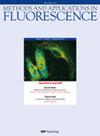3-aminoquinoline: a turn-on fluorescent probe for preferential solvation in binary solvent mixtures
IF 2.4
3区 化学
Q3 CHEMISTRY, ANALYTICAL
引用次数: 0
Abstract
3-Aminoquinoline (3AQ) has been used as a fluorescent probe for preferential solvation in hexane-ethanol solvent mixtures. Results of the present experiment have been put into context by comparison with prior observations with 5-aminoquinoline (5AQ) as the probe. 3AQ exhibits a relatively small change of dipole moment (Δμ = 2.2 D) upon photoexcitation, compared to 5AQ (Δμ = 6.1D), which might appear to be a hindrance in the way of its use as a solvation probe. Indeed, the values of parameters like spectral shifts are smaller for the present experiment with 3AQ. At the smallest concentration of alcohol used, its local mole fraction around the probe is significantly lower than in the previous experiments with 5AQ. However, these apparent disadvantages are outweighed by the significant increase in fluorescence intensity and lifetime observed with increasing concentration of ethanol in the solvent mixture, as opposed to the drastic fluorescence quenching that occurs for 5AQ. This is a marked advantage in the use of 3AQ in studies like the present one. The local mole fraction of ethanol and preferential solvation index experienced by 3AQ are in line with those reported for 5AQ. The disadvantage of the smaller magnitude of Δμ persists in the time resolved fluorescence experiments, for solvent mixtures with very low ethanol content. Negligible wavelength dependence of fluorescence transients of 3AQ is observed for x p = 0.002,. However, this effect is outweighed at higher alcohol concentrations, for which nanosecond dynamics of preferential solvation is observed.3-氨基喹啉:一种用于二元溶剂混合物中优先溶剂化的开启荧光探针
用3-氨基喹啉(3AQ)作为荧光探针,在己烷-乙醇混合溶剂中优先溶剂化。将实验结果与先前以5-氨基喹啉(5AQ)为探针的观察结果进行了比较。与5AQ (Δμ = 6.1D)相比,3AQ在光激发下的偶极矩变化相对较小(Δμ = 2.2 D),这可能会阻碍其作为溶剂化探针的使用。事实上,在目前的3AQ实验中,谱移等参数的值更小。在最小酒精浓度下,其在探针周围的局部摩尔分数明显低于先前使用5AQ的实验。然而,随着溶剂混合物中乙醇浓度的增加,荧光强度和寿命显著增加,而不是发生在5AQ中的剧烈荧光猝灭,这些明显的缺点被抵消了。在像现在这样的研究中使用3AQ是一个明显的优势。3AQ的局部乙醇摩尔分数和优先溶剂化指数与5AQ一致。在时间分辨荧光实验中,对于乙醇含量非常低的溶剂混合物,仍然存在Δμ量级较小的缺点。在x p = 0.002时,观察到3AQ荧光瞬态的波长依赖性可以忽略不计。然而,在较高的酒精浓度下,这种效应被抵消了,因为可以观察到纳秒级的优先溶剂化动力学。
本文章由计算机程序翻译,如有差异,请以英文原文为准。
求助全文
约1分钟内获得全文
求助全文
来源期刊

Methods and Applications in Fluorescence
CHEMISTRY, ANALYTICALCHEMISTRY, PHYSICAL&n-CHEMISTRY, PHYSICAL
CiteScore
6.20
自引率
3.10%
发文量
60
期刊介绍:
Methods and Applications in Fluorescence focuses on new developments in fluorescence spectroscopy, imaging, microscopy, fluorescent probes, labels and (nano)materials. It will feature both methods and advanced (bio)applications and accepts original research articles, reviews and technical notes.
 求助内容:
求助内容: 应助结果提醒方式:
应助结果提醒方式:


